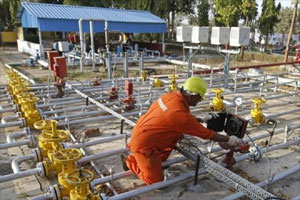After facing a drop in crude oil production for the past seven years, government-owned explorer ONGC has surpassed last year’s output of 22.247 million tonne to produce 22.262 million tonne of oil in FY15. Even though the increase is marginal, it indicates ONGC’s efforts to turnaround its production profile despite constraints of ageing fields and depleting resources from them.
The increase in output in the fiscal year that ended on March 31 is due to better performance of the PSU’s assets in the western offshore region.
“Displaying a remarkable turnaround, crude oil production from western offshore fields, which contributes about 70% of the explorer’s total domestic production, exceeded 3,32,000 barrels per day (bopd) on March, 12. Averaging about 3,27,500 bopd for March, this is the highest production rate from the western offshore since 2008,” a source told FE.
ONGC is successful in reversing the crude oil production trend from all its offshore fields from what was prevailing in the past seven years. The output from these assets in FY15 is pegged at 14.74 million tonne as against 13.71 million during FY14, recording an increase of around 1 million tonne.
According to industry watchers, globally, production from similar ageing fields has witnessed decline at an average of 6-7% every year.
However, ONGC is able to arrest the decline at below 3%, a creditable one. “With meticulous use of technology-enabled processes like improved oil recovery (IOR) and monetizing offshore marginal fields in an innovative way, ONGC had successfully arrested the decline in offshore, first time in the last seven years, establishing itself in the league of world’s best brown-field managers,” said the source quoted above.
In contrast with the average production of 2,85,330 bopd from offshore fields in FY14, the daily production has moved up to 3,07,265 bopd in FY15, registering over 7.7% year-on-year growth. “Embarking on innovative approach in offshore fields such as Mumbai High, which is producing for close to four decades, has helped not only arrest the decline successfully but also grow in a sustained manner,” said another official, adding, “use of technologies such as horizontal sub-sea completion, hydro-fracturing in basal clastics (the lowest layer, usually tight in nature, in an existing sedimentary basin) and gas lift propelled this growth.”
Commissioning of floating production and storage offloading (FPSO) has also fast-tracked production from Cluster-7 of Western Offshore.
Speedy monetization of marginal fields including D1 and B-193 has also added to the production enhancement. The next major greenfield project KG-DWN-98/2 is also being developed on fast track on the eastern offshore. With the production from this field being expected from 2018-19, ONGC aims to make a complete turnaround.
Meanwhile, ONGC saw its gas output declining to 22.016 billion cubic metres (bcm) in FY15 against 23.28 bcm in FY14. This is primary because production from its fields in Eastern region were hampered post fire tragedy at GAIL pipeline in East Godavari district of Andhra Pradesh.
